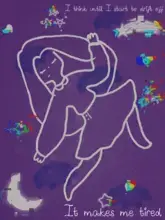Over the course of spring 2021, 29 middle school students from The San Francisco School in San Francisco, CA explored means of creative expression as they crafted multi-media vignettes capturing their pandemic experiences. Transforming isolation to art, they created pieces that utilize original drawings and deeply honest narration to capture the truly underreported stories of youth navigating the COVID-19 pandemic.
The project, developed by humanities and visual art educators at The San Francisco School, was inspired by the graphic memoirs that are part of “Report Card,” a Mission Local project supported by the Pulitzer Center and the Wallace House, where editor and reporter Sindya Bhanoo is a Knight-Wallace Reporting Fellow. The project utilizes illustration and audio to highlight the unseen hurdles that students in underserved communities are facing this year. Many of the stories are written by students themselves, and all stories feature original art.
San Francisco School educators and students first met with Bhanoo and Mission Local editor Lydia Chavez in December 2020 for a virtual presentation on how Mission Local journalists collaborated with youth throughout the Mission District to document underreported impacts of the pandemic. After the presentation, visual art teacher Sadie Wilcox and humanities teacher Araceli Quezada saw an opportunity to introduce an innovative curriculum to the classroom. With the support of Nancy Nagramada, Head of Upper School, they developed the Pandemic Storytelling Project for eighth-grade students.
I knew it would be a meaningful exercise for students to reflect on their learning experience during this pandemic. I felt that writing and producing images would be a lasting record of their experience.
Students began the Pandemic Storytelling Project with a group brainstorm. They went to the parking lot with chalk in hand and began documenting the past year, from January 2020 through December 2020. As they drew, students captured themes related to the pandemic, the presidential election, and the Black Lives Matter movement.
Students then participated in a series of writing sessions with humanities teacher Araceli Quezada. In addition to guiding students in reflecting on their own experiences with the pandemic, these writing sessions emphasized historical thinking and primary sources, especially first-hand accounts. “I then emphasized that every person has a story that is important to the historical record and shared that writing about their experience with learning and school during this pandemic would someday help others to understand what we are living through,” Quezada wrote in a post-project survey.
After students developed written content with Quezada, they illustrated their stories in art class with the support of visual arts teacher Sadie Wilcox. Illustrated panels included handmade drawings, watercolor paintings, multi-media collage art, and digital artwork.
I offered this project to Middle School students so they could have the opportunity to document their pandemic experience through the arts,” wrote Wilcox in a post-program survey. "Not only can visual arts and writing be used as a tool for self-expression, but they provide an opportunity to better understand each other's lived experiences.
After drafting a series of designs for their projects, students met with journalists, illustrators, and editors from Mission Local for a workshop of their final pieces. After receiving feedback from experts in the field, and conducting a peer review, students went on to construct the final drafts of their pandemic stories project.
So much of this school year was defined by change and uncertainty, yet through this project students and educators were able to overcome challenges and share beautiful accounts that will forever be a part of history. After completing their projects, students shared their experience throughout this project with the Pulitzer Center through post-project surveys. For many students, this was an exercise of reflection and allowed them to reconnect with the things that matter the most.
“This project allowed me to reflect on what has been meaningful to me during this pandemic. I also got the chance to appreciate all the things I am grateful for, especially my family,” wrote Nyla, 14.
“This project has inspired me to continue telling my story and sharing my experiences,” added Susanna, 14.
“I enjoyed working with experienced writers and artists, and I learned more about myself and my journey and how I handled this year,” wrote Rell, 14.
The students’ final pieces are included in the Padlet above. They reflect stories of worry, curiosity, hope, and resilience. When asked if she would repeat the project in the future, Quezada wrote, “Absolutely!!! I would recommend it and I would love to do this again next year.
Wilcox agreed, adding, “I can imagine the Pandemic Stories project being made available to teens across the country." If you would like support connecting underreported news stories and journalism skills to students, please reach out to us by emailing [email protected]
This project is supported by the Center’s Bringing Stories Home initiative designed to help U.S. newsrooms cover the big, underreported stories that affect us all. Bringing Stories Home represents an investment in local news, providing resources to cover stories that might not otherwise get told. The Pulitzer Center has collaborated with partner outlets in many cities, including Mission Local, an independent, bilingual news site based in San Francisco, CA.



















